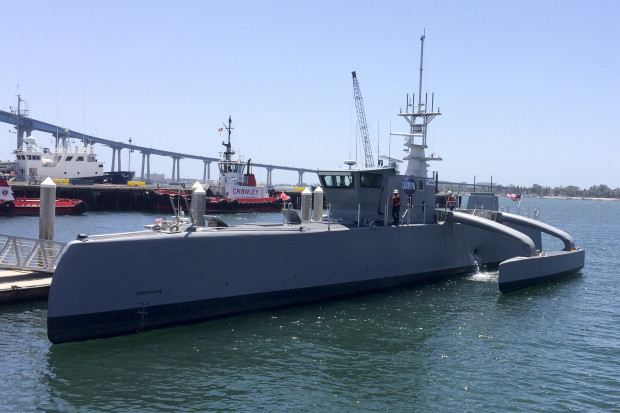Military tests unmanned ship designed to cross oceans

A self-driving, 132-foot military ship sits at a maritime terminal Monday, May 2, 2016, in San Diego. The Pentagon’s research arm is launching tests on the world’s largest unmanned surface vessel designed to travel thousands of miles out at sea without a single crew member on board. AP
SAN DIEGO, United States — The military is launching tests on the world’s largest unmanned surface vessel — a self-driving, 132-foot ship designed to travel thousands of miles out at sea without a single crew member on board.
The so-called “Sea Hunter” has the potential to revolutionize not only the military’s maritime operations but commercial shipping, according to military officials. If successful, it could usher in the arrival of unmanned cargo vessels moving between countries.
READ: ‘King Kong’ research ship from US Navy heads for PH
Military officials showed off the ship in San Diego on Monday before it set sail to a nearby Naval base where the testing will be conducted. The sleek, futuristic-looking steel-gray vessel was docked at a maritime terminal in the heart of San Diego’s shipbuilding district, where TV crews filmed the robotic craft. No media access was given to the inside of the vessel.
The Pentagon’s research arm, the Defense Advanced Research Projects Agency, or DARPA, developed the ship along with Virginia-based Leidos. DARPA will test it in conjunction with the Navy over the next two years off California’s coast. The tests will largely focus on its ability to react on its own to avoid collisions with seafaring traffic.
Article continues after this advertisementREAD: Coming soon: a brain implant to restore memory
Article continues after this advertisement“For our military operations we want to make sure we have unmanned vessels like this to supplement the human mission so that we’re not putting people unduly in harm’s way,” said DARPA spokesman Jared B. Adams.
During the testing phase, the ship will have human operators as a safety net, but once it proves to be reliable, the autonomous surface vessel will maneuver itself — able to go out at sea for months at a time.
Program manager Scott Littlefield said there will be no “remote-controlled driving of the vessel.” Instead it will be given its mission-level commands telling it where to go and what to accomplish and then software will enable it to drive itself safely.
The military initially built the diesel-powered ship to detect stealthy diesel-electric submarines, but developers say they believe it has the capability to go beyond that, including detecting mines. There are no plans at this point to arm it.
“There are a lot of advantages that we’re still trying to learn about,” Littlefield said.
Some see the possibility that the full-size prototype could pave the way to developing crewless cargo vessels for the commercial shipping industry someday, he added. Countries from Europe to Asia have been looking into developing fleets of unmanned ships to cut down on operating costs but the idea has sparked debate over whether it’s possible to make robotic boats safe enough to run on their own far from land.
The International Transport Workers’ Federation, the union representing more than half of the world’s more than 1 million seafarers, has said it does not believe technology will ever be able to replace the ability of humans to foresee and react to the various dangers at sea.
Others have expressed concern about hackers capturing a robotic vessel.
Military officials have been working on hacker-proof protections and say it’s possible to make drone ships cyber-secure.
The “Sea Hunter” was built off the Oregon coast, and moved on a barge to San Diego’s coastline. The prototype can travel at a speed of up to about 30 mph and is equipped with a variety of sensors and an advanced optical system to detect other ships.
The program to develop the ship cost $120 million, though DARPA officials say the vessels can now be produced for about $20 million.
During the collision tests, the ship will be programed to follow international traffic rules for traditional boats of its size.
Commercial ships must have a minimal number of crew members and there are no standards for unmanned ships yet, but military officials believe that could change if vessels like this one make it out of the experimental stage.
The Navy over the years has experimented with a number of unmanned systems — from drone helicopters to small, remotely controlled boats launched from ships. The Pentagon’s budget over the next five years calls for investing in more high-end Naval ships, including $600 million to be invested in unmanned undersea vehicles.